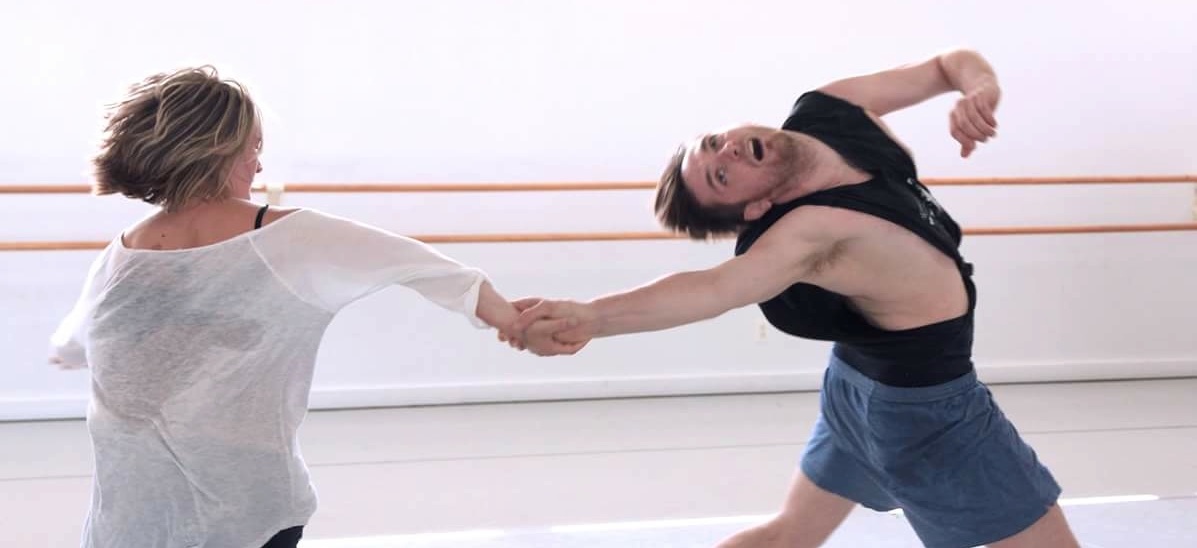When New York City-based freelance dancer Jace Coronado plans his day, he allows just enough subway travel time from rehearsal to rehearsal…to rehearsal. And that’s considering the transit system is on its best behavior. During this travel time, he’s probably going through choreography for his next rehearsal, scheduling the logistics of his next gig, or perhaps just relishing in a chance to sit down and relax. Such is the life of a freelance dancer: always on the go.
Freelance dancers such as Coronado may rehearse with two to four companies or choreographers at a time. In addition, many have “side jobs” to supplement their dancing income, to allow for rent, food, transportation, everyday living and maybe savings. Most freelance dancers would admit the lifestyle can be hard, sometimes draining, perhaps not for everyone, but at the same time, it allows them to be their own boss, to choose what they’re dancing and with whom, and to become an even more artistically challenged and charged dancer.
Here, Dance Informa speaks with three NYC freelancers on what the life is like and how they stay sane and in the game.

Jace Coronado, pictured as Albrecht in ‘Giselle’, was a member of a full-time company before becoming a freelance dancer. Photo courtesy of Jace Coronado.
The Choice
Coronado, like some freelance dancers, began his career as a full-time company member. He apprenticed with Ballet Austin after college and then was a member of Ballet Memphis for seven years. Prior to his move to NYC, Coronado dabbled in freelance work as a guest artist and ballet master. It was after he moved to NYC, landed a Broadway show, which closed 14 months later, however, that Coronado launched full-fledged into his freelance career.
He recalls being in Nancy Bielski’s ballet class, thinking he would transition from dance to strictly musical theater, when she asked what he was doing with his life.
“She said to me, ‘You are not quitting. You are quite good actually. So you are going to Buffalo to perform Balanchine’s Agon. So you should get in shape.’ I laughed and said, ‘Okay!’ And that was it! So began my almost five-year career as a freelancer,” he says.
Since then, Coronado has freelanced with a number of companies, including Neos Dance Theatre, Northeast Youth Ballet, City Center Ballet, Ballet NY, Ballet Verite, Thomas Ortiz Dance, Jane Comfort and Company, Roxey Ballet, Leggz Dance, Neglia Ballet Artists, New England Academy of Dance, Damage Dance and MorDance. He has also performed in many theater productions and is currently doing a six-month season in St. George, Utah, at Tuachan Center for the Arts.
Similarly, dancer Dorothea Garland, originally from the Boston area, danced with a company in Cambridge, Massachusetts, before moving to NYC in 2005 and starting her freelance career.
“I had this restlessness to see what else was out there and a big curiosity about dancing in New York City,” she recalls.
Since then, Garland has found herself working with Ballets with a Twist, which she says is her primary dancing job, Donna Salgado’s CONTINUUM Contemporary/Ballet, David Fernandez’s Some Dance Company and, most recently, in the new rock opera, The Life and Death of Kenyon Phillips.
Other dancers, such as freelancer Brynt Beitman, have chosen to work their entire career dancing with multiple companies. Beitman, originally from Texas and a Juilliard graduate, has lived in NYC on and off for 11 years and currently dances with Lydia Johnson Dance, Heidi Latsky Dance and TAKE Dance.

NYC freelance dancer Dorothea Garland performs with Ballets with a Twist, among other companies. Photo by Nico Malvaldi.
Who’s The Boss?
In a sense, being a freelance dancer means being the boss. Freelancers are responsible for keeping track of their schedule, going to class or warming up before rehearsal, budgeting and sometimes negotiating fees, and keeping each choreographer or director happy by devoting their time.
“As a company member, your schedule, coaching, repertoire, ballet shoes and dance belts are all there for you,” Coronado says. “As a freelancer, you have to do the work for yourself.”
“I have to continuously evaluate where I am and where I want my career to go,” Beitman adds. “It’s like I am my own director choosing the rep I do when I agree to work with people. In a full-time company, your path is more laid out for you. Working for a full-time company also keeps you in class consistently. In freelance, you have to make sure you carve out time in your schedule to stay in shape.”
Schedule Juggling
Many freelancers would agree that scheduling is one of the hardest parts of their lifestyle. Communication about rehearsals and performances is often done through emails, so organization is an important asset.
“I’m usually working with three or four people a week,” Beitman explains. “I always give priority to those who have the nearest show date. No one wants to hear you can’t be at their rehearsal. From their point of view, they are offering you an opportunity. I try to be as respectful and grateful for that as I can. People understand that if they can’t pay you full-time, they can’t expect you to always be there. But if you are there whenever you possibly can, they see that and know you are committed to their work.”
Coronado adds that although a freelancer’s schedule can sometimes come in waves due to project-to-project-based work, it’s important to not overextend oneself.
“After all, your body is your instrument, and you want to make sure that it can sustain the hours of rehearsals that are required of you,” he says. “Doing your homework before you head out of town or to your rehearsal I found always helped maximize my time.”

Brynt Beitman performs with several stipend-based companies. Photo by Kenji Mori.
The Money Factor
Not having a full-time contract with consistent pay can sometimes leave freelancers concerned for cash. To alleviate this stress, many freelance dancers have “side jobs” as an income buffer between gigs, or alongside their weekly rehearsal schedule(s).
Garland, who dances with companies that are project-to-project or stipend-based, supplements her income through teaching jobs and occasional restaurant work. She also says the Ballets with a Twist Director, Marilyn Klaus, makes sure her dancers are employed in one capacity or another, whether through dancing, teaching or even office or administrative work.
When money does become a source of stress, Garland says, “I try to tell myself it’s worth it and it will, and always does, work out. More practically speaking, I can always pick up extra work from one of my other jobs if necessary.”
Beitman dances with one company that is stipend-based and two that are stipend with an hourly rehearsal rate paid monthly. In addition, he teaches Pilates, substitutes dance classes and creates his own work.
“I’ve found that there is an element of resourcefulness that successful freelancers have,” Beitman says. “Money has been an issue. I try to have open communication about fees with employers. I treat myself like a business. I keep an emergency fund. There are a lot of tax write-offs for performers as well. The longer I work, the more opportunities arise. Money has become less of an issue. I’ve had to be able to roll with the punches and plan for the future at the same time.”
Coronado, who says most of his freelance work is paid hourly for rehearsals and with a set performance fee, also works as a Master Rehabilitative Pilates Equipment Instructor for Equinox. This “side job”, he says, allows him to cross-train at no cost and to give back to others while taking attention away from himself.
“One thing I did find changed the way money came into my life through this business was to not accept a gig for monetary gain alone,” Coronado explains. “Yes, there are times when you just need to pay your rent, so you do what you have to do, but I always told myself, and continue to tell myself, ‘If it’s not fun, I don’t want to do it.’”
Staying Sane
A freelancer’s life can be hectic, and many rarely have a day off due to their hodgepodge schedule. That means, then, that any free moment, and that cherished day off, is a welcomed way to unwind.
“My life is hectic,” Beitman says. “That means my home is super important to me. I live in a place that is quiet and calm. I couldn’t have it any other way. I don’t always get the downtime I need, but I try.”
“Most of my downtime is spent during the travel to and from gigs and rehearsals and in silent meditation,” Coronado adds. “It can wear on you, and if you are not careful, you will burn out.”

Freelancer Dorothea Garland performs with Ballets with a Twist. Photo by Nico Malvaldi.
Artistic Rewards
Freelancing certainly keeps life interesting; day to day is different. Dancers work with choreographers of different voices, dance with multiple groups of dancers, rehearse in different studios and perform at any given venue. These types of experiences can aid in an artist’s growth. Life will hardly become flat and monotonous.
“I get to use my body and training in different ways,” Beitman comments. “I think it has helped me get to know myself as an artist to have input from many different voices. I can see different applications of ideas that are universally successful and incorporate them into my physicality and choreographic lexicon.”
“If you manage to find choreography you like from a director whom you connect with and a consistent group of people you enjoy dancing with, then you’ve hit the freelance lottery,” Garland says. “If those or other things aren’t happening, you can choose to walk away and find something else, knowing that it’s not the end of the world.”
“Once you learn to juggle it all, there is so much freedom and opportunity to be had in this world,” Coronado adds. “There were roles I had the privilege to perform that I would never had been cast as in a company setting. Albrecht in Giselle, for example, or Cavalier for Sugar Plum. Freelancing pushed my limits as a dancer and the limitations I had placed on myself and made me a far greater dancer than I ever imagined I could be.”
Is It For Everyone?
Freelancing can be equally hard and beneficial, but it takes a lot of work. Coronado says it requires “thick skin” and the ability to say when enough is enough. Beitman adds that it takes a lot of perseverance. Garland says it habituates an adeptness of “unusual circumstances”.
“I know a lot of people who it didn’t work for,” Garland adds. “I think if you are going into freelance, whether by choice or as a plan B, keep in mind a sort of flexible vision of what you want from it and how it will add to your artistry. It can be easy to get caught up in how busy you become, particularly juggling so many jobs. Stay present and enjoy it – nothing is worth anything without those two things.”
“Only do it if the joy you get from it outweighs its difficulties,” Beitman advises. “Be gracious to everyone. No one wants to work with a jerk. Don’t take just any work. Know when it’s time to move on. Do work that you enjoy and keeps you learning. Don’t settle. Stay interested in constantly recommitting to your craft. You are never done improving. Don’t be satisfied with what you did yesterday, but know that sometimes an ‘E’ for ‘Effort’ is okay. Be kind to yourself. Don’t worry so much about what you learned in school or what you thought things were going to be like. Your experience is your own. Don’t compare yourself to others. There is no right way to be a dancer. Be grateful that you have dance in your life and get to do what you love.”
By Laura Di Orio of Dance Informa.
Photo (top): Freelancer Brynt Beitman currently works with three companies in NYC. Photo by Jaqlin Medlock.
















Pingback: The Freelance Game: Could You Be a Freelance Dancer? - Dance Life